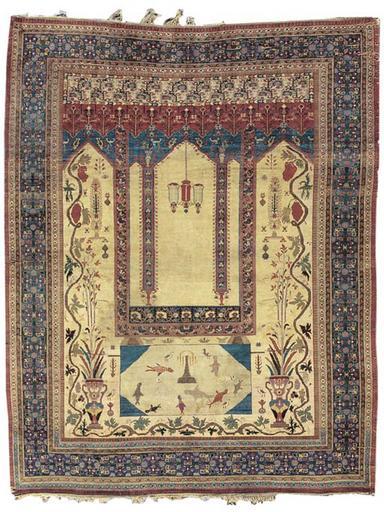MAKE A MEME
View Large Image

| View Original: | An_example_of_the_remarkable_cultural_complexity_of_the_Deccan....jpg (512x683) | |||
| Download: | Original | Medium | Small | Thumb |
| Courtesy of: | commons.wikimedia.org | More Like This | ||
| Keywords: An example of the remarkable cultural complexity of the Deccan....jpg en A SILK DECCANI PRAYER RUG Central India last quarter 19th century or earlier The ivory field with a pair of polychrome baluster vases issuing delicate floral sprays surrounded by bold scrolling vine hanging grapes delicate floral motifs and a stylised cypress tree an ivory rectangular lozenge enclosing stylised fish animals a central fountain and blue spandrels all below a rectangular Turkish style prayer panel with a pair of blue floral columns supporting a central handing triple bell-shaped vase above in a brick-red floral frame with a blue floral band below and light blue and brick-red arcaded angular arch above containing delicate floral and stylised plant-motifs ivory angular floral band above in a light blue dense angular floral border between ivory and pistachio-green meandering flowerhead vine stripes outer reciprocal skittle-pattern stripes even wear slight splitting dry 6ft 5in x 5ft 2in 196cm x 157cm Lot Notes There is nothing quite like this remarkable rug in the published literature It combines a central motif from Turkey with various other motifs from India particularly the border and also has a number of features which could demonstrate a Persian origin Only one rug has been published which in any way resembles it; a piece which appeared at auction in 1992 Sotheby's London 28 April 1992 lot 167 Both rugs are technically similar being made with a very flat back and with tightly trimmed pile Both have intricate main borders between multiple minor stripes and fields which have a variety of motifs all of which have been very delicately drawn In both there is a central panel of design and a variety of fish in the lower part which here is a pond while on the other it is a stream together with very delicately drawn floral motifs at either side Both also use a great variety of vibrant colours And they even have an identical outermost guard stripe not only in design which is after all very frequently encountered but also in the same colour combination The larger carpet is thought to have been made in the Deccan in the early 18th century This attribution and dating were made by comparing the motifs to those of Indian painting as well as a certain superficial similarity to the well-known group of 18th century pashmina carpets With no published rugs to compare it to the attribution made perfect sense The weaver of the present rug obviously started off with the intention of weaving another floral design; the bases of two trees very similar to the central tree of the larger carpet can be distinguished above the two sides of the pool But then the design completely changed and a completely foreign motif of a Turkish prayer rug was superimposed The Turkish rug itself is a combination of various Anatolian originals One can see motifs typical of Ghiordes in the lower dark and upper light blue cross-panels These have been combined with elements from Ladik in the red arched cross-panel and the blue spandrels And hanging from the central arch is a lamp which looks at first glance to be remarkably 19th century Birmingham in form There is little doubt that the rug was made in India and an attribution to the Deccan cannot be refuted The presence of the Turkish elements within the design however make an early 18th century date virtually impossible The rugs which have these designs can be traced back to the second half of the 18th century and thus with the possible exception of the hanging lamp an 18th century date is not precluded If however the date is as early as this what were Turkish prayer rugs of a type not designed for export doing in India They would have seemed remarkably coarse in weave to the patrons who would have appreciated the present rug It is more probable that the designs were incorporated from one of the first carpet books produced in the last quarter of the nineteenth century Despite all the discussion about origin and in particular dating which this rug will provoke it is certainly beautifully made and with a brilliant finesse of drawing and colour which is very rare to find in rugs last quarter 19th century or earlier http //www christies com/Lotfinder/lot_details aspx sid intObjectID 4161167 SE CMWCAT04+110936+302597546+ QR M+1+117+Aqc0000900+101420++Aqc0000900+ entry india SU 1 RQ True AN 118 http //www columbia edu/itc/mealac/pritchett/00routesdata/1700_1799/hyderabad/prayerrug/prayerrug html Central India PD-Art Uploaded with UploadWizard Deccan style Tapestry of India Prayer rugs 19th-century carpets | ||||